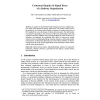Free Online Productivity Tools
i2Speak
i2Symbol
i2OCR
iTex2Img
iWeb2Print
iWeb2Shot
i2Type
iPdf2Split
iPdf2Merge
i2Bopomofo
i2Arabic
i2Style
i2Image
i2PDF
iLatex2Rtf
Sci2ools
IFIP
2009
Springer
2009
Springer
Contextual Inquiry in Signal Boxes of a Railway Organization
A number of selected field-study techniques have been validated in a case study in the domain of railway signal boxes. The context of this work is the endeavour of a human-centred design consultancy to acquire know-how on HCI methods for use in the design of safety-critical systems. The field studies were aimed at providing a clear overview of the work environment, tasks and cognitive load of the signallers and of possible bottlenecks in the current way of operating. Our approach for conducting field studies in supervisory control systems is based on ethnomethodology, situation awareness, and mental models ted as an abstraction hierarchy. For each of these methods, we discuss our approach, the result, and the applicability of the technique to future safetycritical system design projects. Keywords. Safety-critical systems, ethnomethodology, patterns of cooperative interaction, situation awareness, goal-directed task analysis, mental models, ion hierarchy
| Added | 26 May 2010 |
| Updated | 26 May 2010 |
| Type | Conference |
| Year | 2009 |
| Where | IFIP |
| Authors | Joke Van Kerckhoven, Sabine Geldof, Bart Vermeersch |
Comments (0)

